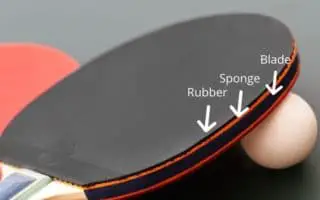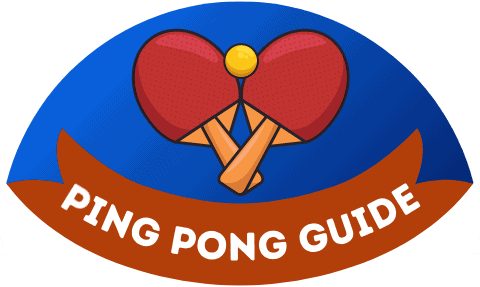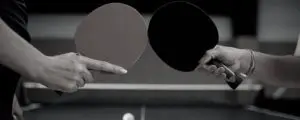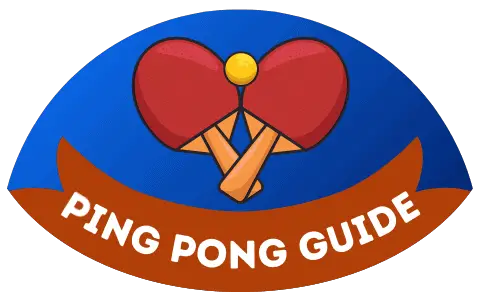Forehand – topspin the ball goes out of bounds. It must have been the bat. I did everything right! If you know situations like this, you might want to reconsider the hardness of your racket. Whether you play with a hard or soft racket has a big impact on your game. In this post you will learn how the two variants differ and how components influence racket hardness.
Hard and soft rackets differ mainly in the contact time with the ball. The soft racket is pressed in a little more by the ball. This gives you a longer time to feel the ball. When leaving the bat, the so-called catapult effect occurs, which additionally accelerates the ball. Hard rackets, on the contrary, implement the stroke movement 1 to 1 without additional help. This gives you 100% control.
Even at the highest level, both hard and soft rackets are played. Both variants have their advantages and disadvantages. Find out which one suits your style of play by reading this article.
Which components influence the racket hardness?
A racket consists of three layers. The basis is the blade, then you got the sponge with the rubber on top of it.

Each of the three components can influence the hardness of a racket. Thus, there are hard and stiff blades, hard and soft rubbers, and sponges of different thicknesses.
I will explain step by step what effects each of these have on the characteristics of the racket.
Soft vs. Stiff Blade – The difference,
We start from the inside out – that is, with the blade. Not all blades are the same. There are different properties here as well.
Stiff Blades
Stiff blades are usually a bit heavier. Often other materials are used, such as carbon, which make the racket heavier and harder. Due to the higher weight, you can generate more drive when hitting the ball.
A stiff wood is not as elastic as softer blades. This reduces the contact time with the ball. However, this also leads to the fact that your own swing is converted 1 to 1. This means that you have full control over the shot.
When playing with stiffer woods, you get direct “feedback” from your paddle. It is easier to notice when you have made a mistake because it vibrates less.
Soft Blades
With soft blades, you don’t get this direct feedback, because the wood is more elastic. However, this also has great advantages.
You have slightly longer contact with the ball, which gives you more time to give the ball the desired direction and rotation. This is especially advantageous in passive play, i.e. when blocking.
The corresponding vibration, however, has another advantage and that is called the catapult effect. You can imagine it like a trampoline. On contact with the racket, the ball is accelerated additionally.
This means that softer woods are even somewhat faster, although the ball does not always fly exactly to where the own swing would have placed it.
Who Plays Which Blade?
In general, most advanced players tend to play stiff woods because they don’t need the catapult effect due to their technique and prefer to have full control of the ball.
However, if you want to generate the maximum speed with your strokes you should consider using a soft blade.
Soft vs. Hard Rubber – The Difference
The rubber can also influence the hardness of the table tennis bat. The effect can come from both the thickness of the sponge and the texture of the rubber. The thicker the sponge, the softer the rubber.
The effects are similar to those of the blades
Hard Rubber – Thin Sponge
Compared to the stiff wood, with hard rubber, you have less catapult effect but full control, and your stroking movement is converted exactly. Due to the lack of effect, the strokes may be a bit slower.
The full control also means that hard rubbers actually have no fault tolerance and punish insufficient technique.
For a block, hard rubber is advantageous, as it allows the ball to bounce further off the racquet without active movement.
Soft Rubber – Thick Sponge
A softer rubber makes the racket more elastic. This allows you to benefit from the catapult effect and – despite perhaps not quite perfect technique – to play fast and hard balls. Soft rubber is therefore more “forgiving” of your own mistakes than a hard one.
A soft surface increases the contact time with the ball but is not 100% consistent with your strokes. So you don’t have “full control”. However, you can generate more spin due to the longer contact with the ball.
When blocking, soft rubbers can cause the ball to fall away without active movement.
When playing far away from the table, soft rubbers are advantageous because the catapult effect helps to bring blocks to the opponent’s plate.
Who Plays Which Rubber?
Unlike blades, there is no clear tendency as to which rubbers are favored by professional players. Both types have their advantages. In general, if you play closer to the table, you should choose a hard rubber.
If you play a few steps away from the table, a softer rubber is probably the right choice.
If you like to play aggressively and want to have maximum spin and speed then you’d probably want to choose a softer rubber. If you prefer a rather passive and defensive playing style, a hard rubber might be the right choice.
When Does Which Effect Come into Play?
Now we have taken a closer look at the properties of blades and rubbers. But when do the effects of the blade take effect and when do the effects of the rubber take effect?
With every stroke, both components have their influence. However, the harder your stroke, the more you play the ball with the blade because the ball penetrates the rubber. Of course, this is more likely to happen with a thin rubber.
With lighter strokes, such as the serve, the effects of the rubber are more evident.
What is the Best Combination?
Depending on the playing situation, the effect of the rubber or that of the blade comes into play. Depending on your playing style, you can also combine hard and soft variants, not just get only soft or a hard racket.
If you want to have full control in your attacking balls and blocks but still want to achieve maximum speed and ball rotation, you would for example choose a hard blade and a soft and thick rubber. This is a very popular combination.
Most players make a further distinction between forehand and backhand sides and play different rubbers.
Fast Is Not Always Better
Many players make the mistake of overstating the advantages of maximum spin and speed of soft rackets. However, the resulting catapult effect also has its pitfalls.
Beginners in particular are often overwhelmed by the speed of their own racket and would actually be better off with a slower, harder one. Especially for learning the correct technique, the feedback you get from your paddle is extremely important to improve.
So keep this in mind when choosing yours.





